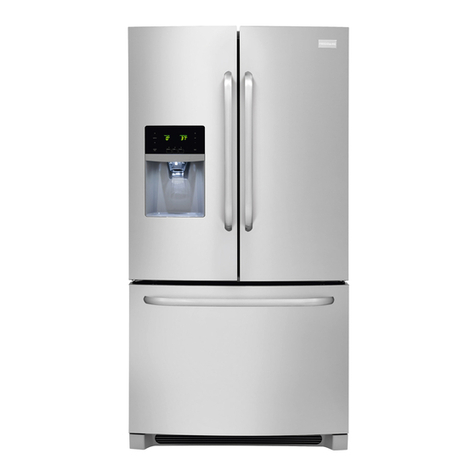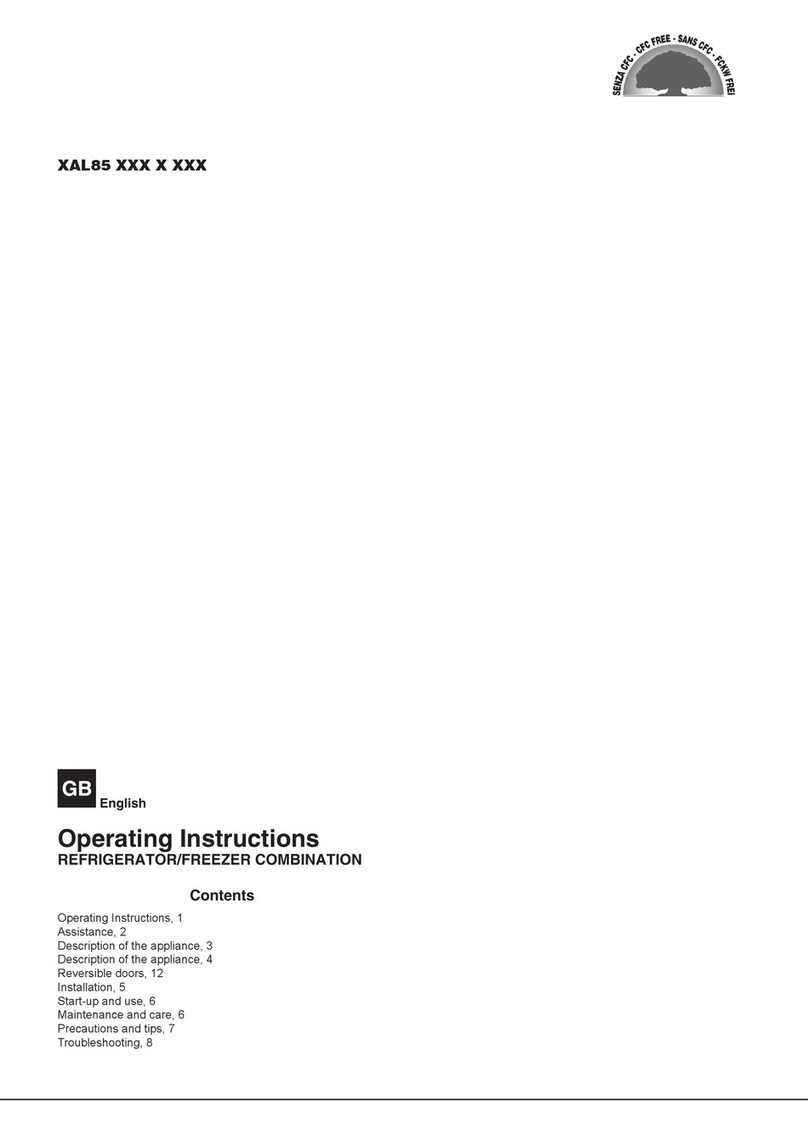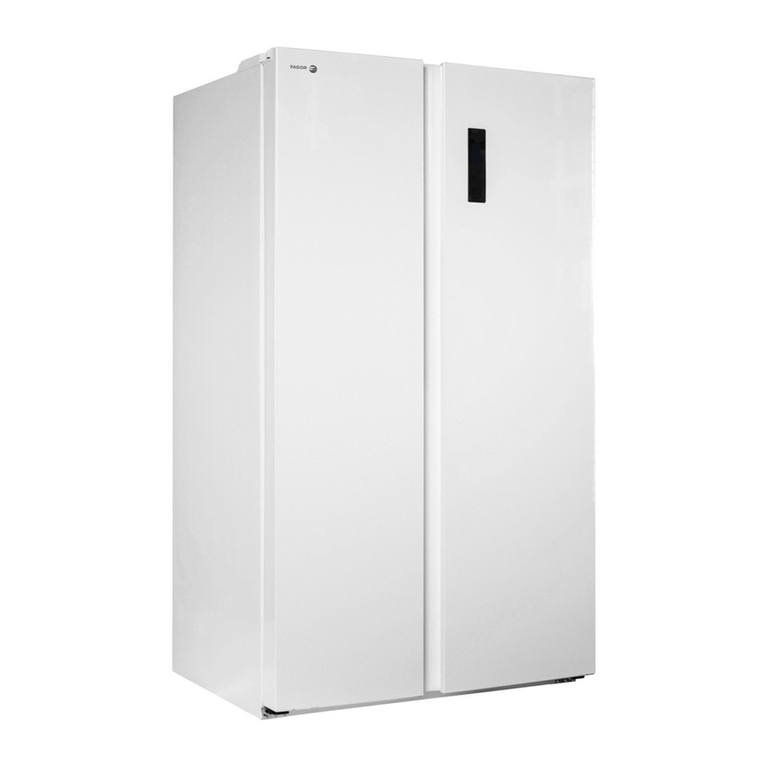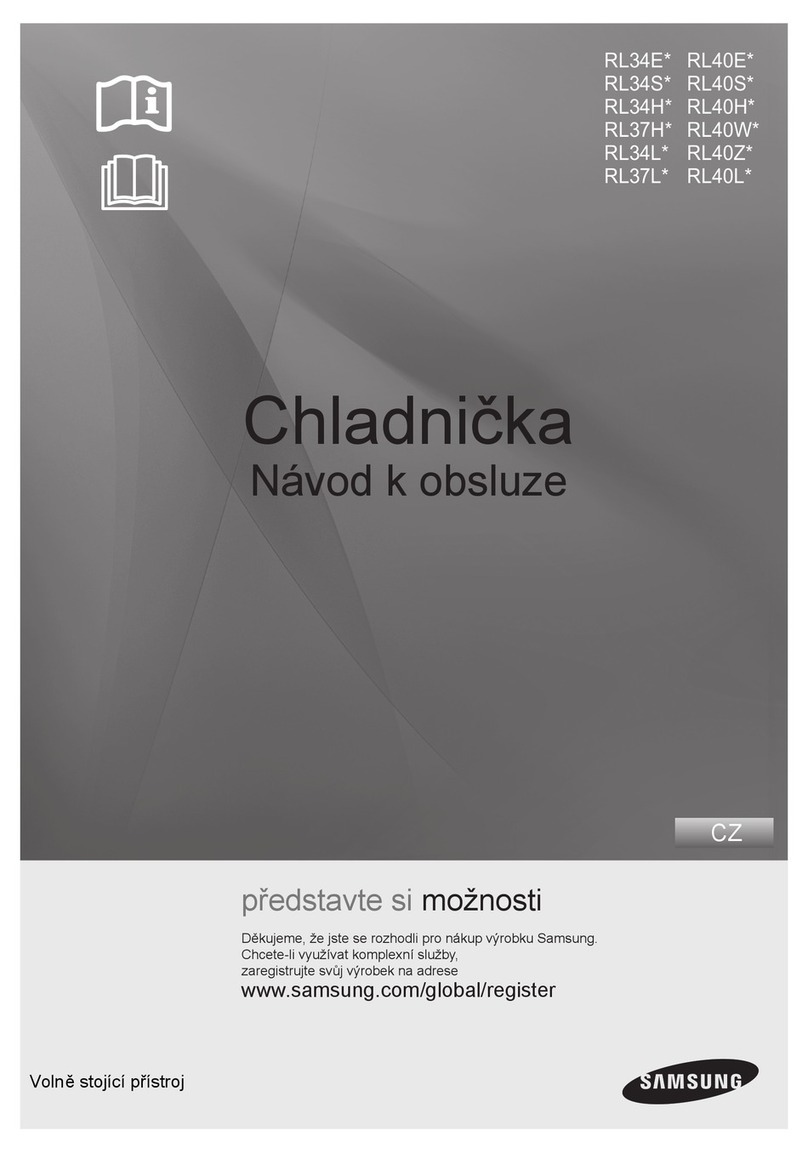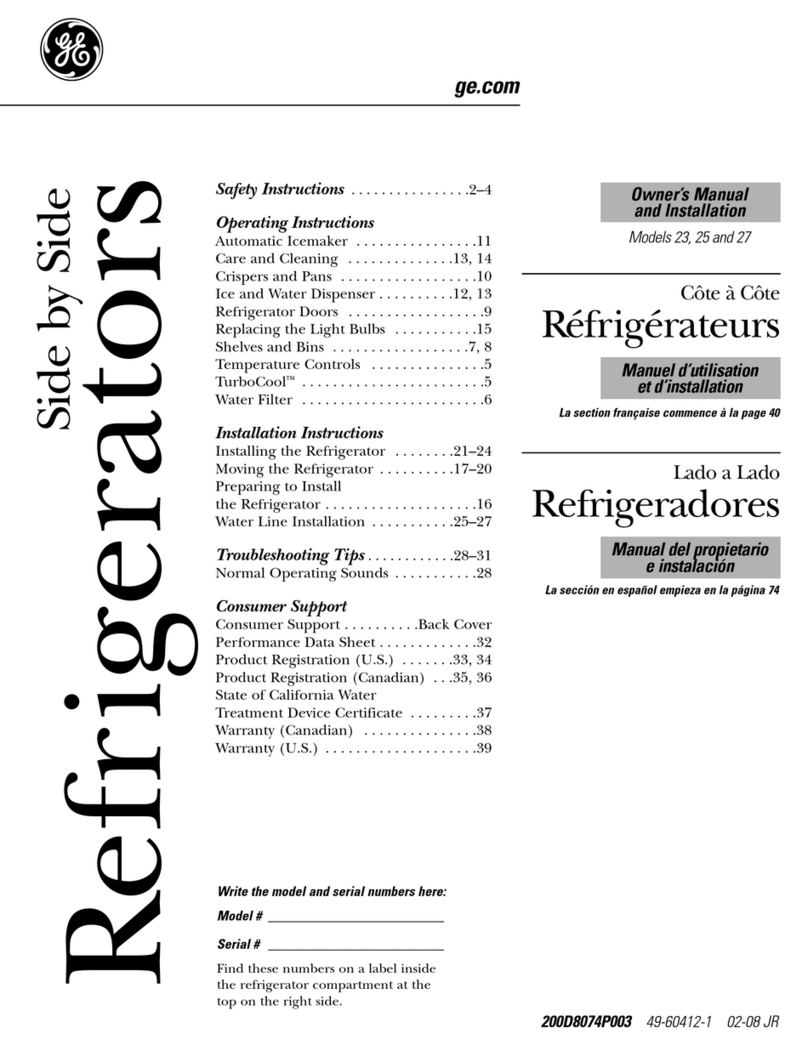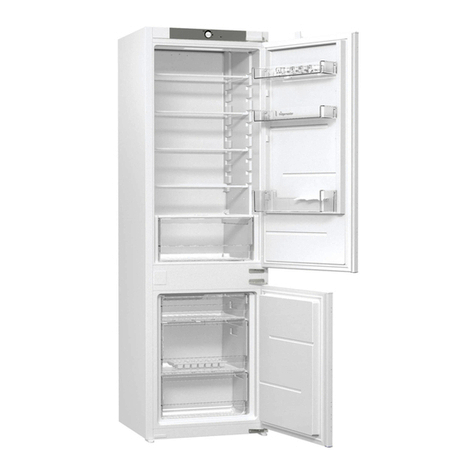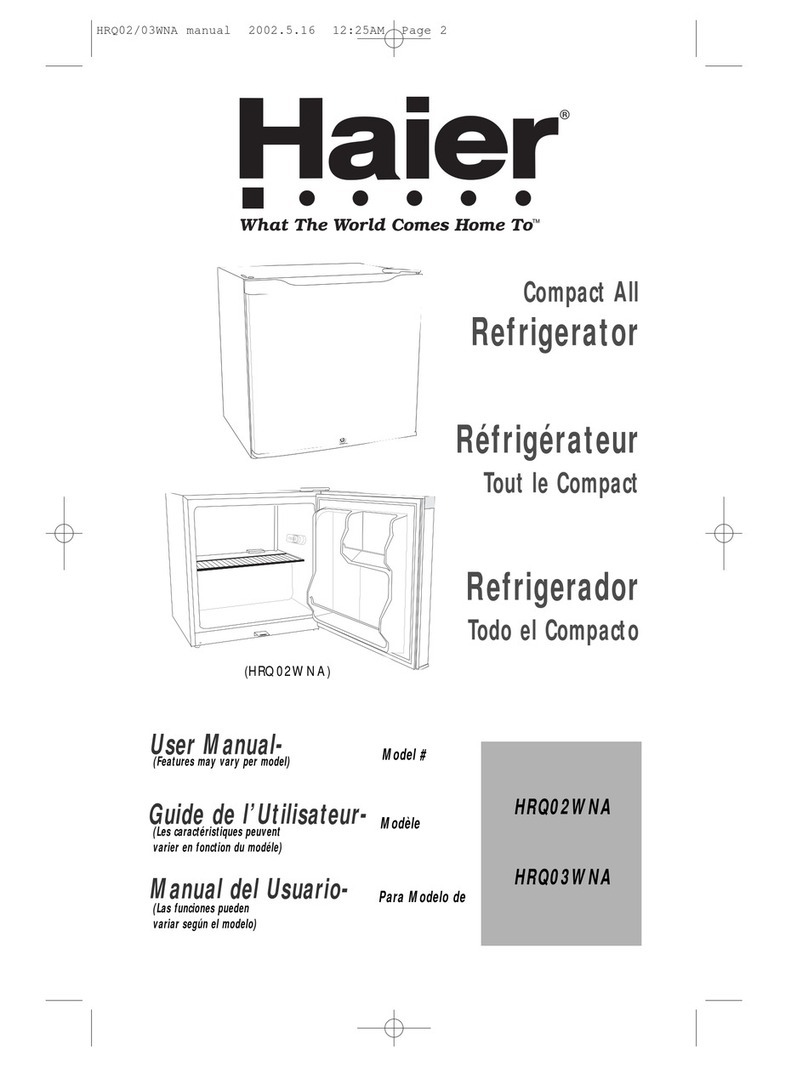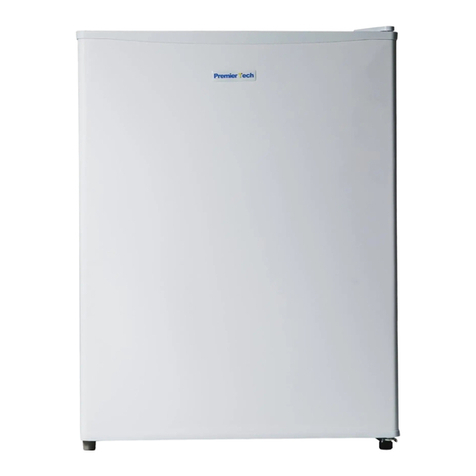ROMMER FL185NF A++ User manual

LARDER
Instruction Booklet
REFRIGERADOR
Manual de Instrucciones
RÉFRIGÉRATEUR
Guide D'utilisation
FL185NF A++
FL186NF A++ INOX

EN - 1 -
Index
BEFORE USING THE APPLIANCE ............................................... 2
General warnings ............................................................................................................... 2
Old and out-of-order fridges or freezer ............................................................................. 4
Safety warnings .................................................................................................................. 4
Before using your fridge ..................................................................................................... 5
Installing and operating your fridge .................................................................................. 5
Information on No-Frost Technology ................................................................................ 6
USAGE INFORMATION ...................................................................................... 7
Control panel ...................................................................................................................... 7
Temperature set button ............................................................................................................... 7
Alarm light .................................................................................................................................... 7
Super Cooling Mode .................................................................................................................... 7
Fridge Temperature Settings ...................................................................................................... 7
Warnings for temperature settings ................................................................................... 8
Accessories ........................................................................................................................ 9
Chiller shelf .................................................................................................................................. 9
Fresh dial ..................................................................................................................................... 9
ARRANGING FOOD IN THE APPLIANCE ........................................................... 9
CLEANING AND MAINTENANCE ....................................................................... 10
TRANSPORTATION AND CHANGING OF INSTALLATION POSITION ............... 11
Repositioning the door .................................................................................................... 11
BEFORE CALLING SERVICE ............................................................................ 11
Tips for saving energy...................................................................................................... 13
THE PARTS OF THE APPLIANCE AND THE COMPARTMENTS ........................ 14

EN - 2 -
CHAPTER 1. BEFORE USING THE APPLIANCE
General warnings
WARNING: Keep ventilation openings, in the appliance enclosure
or in the built-in structure, clear of obstruction.
WARNING: Do not use mechanical devices or other means to
accelerate the defrosting process, other than those recommended
by the manufacturer.
WARNING: Do not use electrical appliances inside the food storage
compartments of the appliance, unless they are of the type
recommended by the manufacturer.
WARNING: Do not damage the refrigerant circuit.
WARNING: In order to avoid any hazards resulting from the instability
of the appliance, it must be fixed in accordance with the following
instructions:
WARNING: When positioning the appliance, ensure the supply cord
is not trapped or damaged.
WARNING: Do not locate multiple portable socket-outlets or portable
power supplies at the rear of the appliance.
SYMBOL ISO 7010 W021
Warning: Risk of fire / flammable materials
• If your appliance uses R600a as a refrigerant (this information
will be provided on the label of the cooler) you should take care
during transportation and installation to prevent the cooler
elements from being damaged. R600a is an environmentally
friendly and natural gas, but it is explosive. In the event of a leak
due to damage of the cooler elements, move your fridge away
from open flames or heat sources and ventilate the room where
the appliance is located for a few minutes.
• While carrying and positioning the fridge, do not damage the
cooler gas circuit.

EN - 3 -
• Do not store explosive substances such as aerosol cans with a
flammable propellant in this appliance.
• This appliance is intended to be used in household and domestic
applications such as:
- staff kitchen areas in shops, offices and other working
environments.
- farm houses and by clients in hotels, motels and other residential
type environments.
- bed and breakfast type environments;
- catering and similar non-retail applications.
• If the socket does not match the refrigerator plug, it must be
replaced by the manufacturer, a service agent or similarly
qualified persons in order to avoid a hazard.
• A specially grounded plug has been connected to the power
cable of your refrigerator. This plug should be used with a
specially grounded socket of 16 amperes. If there is no such
socket in your house, please have one installed by an authorised
electrician.
• This appliance can be used by children aged from 8 years and
above and persons with reduced physical, sensory or mental
capabilities or lack of experience and knowledge if they have
been given supervision or instruction concerning use of the
appliance in a safe way and understand the hazards involved.
Children shall not play with the appliance. Cleaning and user
maintenance shall not be made by children without supervision.
• If the supply cord is damaged, it must be replaced by the
manufacturer, an authorised service agent or similar qualified
persons, in order to avoid a hazard.
• This appliance is not intended for use at altitudes exceeding
2000 m.

EN - 4 -
Safety warnings
• Do not connect your fridge to the mains electricity supply using an
extension lead.
• Do not plug in damaged, torn or old plugs.
• Do not pull, bend or damage the cord.
• This appliance is designed for use by adults, do not allow children
to play with the appliance or let them hang off the door.
• Never touch the power cord/plug with wet hands as this could cause
a short circuit or electric shock.
• Do not place explosive or flammable material in your fridge. Place
drinks with high alcohol content vertically in the fridge compartment
and make sure that their tops are tightly closed.
• Do not cover the body or top of fridge with lace. This affects the performance
of your fridge.
• Secure any accessories in the fridge during transportation to prevent
damage to the accessories.
Old and out-of-order fridges or freezer
• If your old fridge has a lock, break or remove the lock before discarding it,
because children may get trapped inside it and may cause an accident.
• Old fridges and freezers may contain isolation material and refrigerant
with CFC or HFC. Therefore, take care not to harm environment when you
are discarding your old fridges.
Please ask your municipal authority about the disposal of the WEEE reuse,
recycle and recovery purposes.
Notes:
• Please read the instruction manual carefully before installing and using your
appliance. We are not responsible for the damage occurred due to misuse.
• Follow all instructions on your appliance and instruction manual, and keep this
manual in a safe place to resolve the problems that may occur in the future.
• This appliance is produced to be used in homes and it can only be used in domestic
environments and for the specified purposes. It is not suitable for commercial or
common use. Such use will cause the guarantee of the appliance to be cancelled
and our company will not be responsible for losses incurred.
• This appliance is produced to be used in houses and it is only suitable for cooling /
storing food. It is not suitable for commercial or common use and/or for storing
substances except for food. Our company is not responsible for losses to be incurred
in the contrary case.

EN - 5 -
Installing and operating your fridge
Before starting to use your fridge, you should pay attention to the following points:
• Operating voltage for your fridge is 220-240 V at 50Hz.
• Before using your fridge, please call the nearest authorised service for help with the
installation, operation and usage of your fridge.
• W e do not accept responsibility for any damages that occur due to ungrounded
usage.
• Place your fridge where it will not be exposed to direct sunlight.
• Your appliance should be at least 50 cm away from stoves, gas ovens and heater
cores, and at least 5 cm away from electrical ovens.
• Your fridge should never be used outdoors or exposed to rain.
• When your fridge is placed next to a deep freezer, there should be
at least 2 cm between them to prevent humidity forming on the
outer surface.
• Do not place heavy items on the appliance.
• Do not place anything on your fridge, and install your fridge in a
suitable place so that at least 15 cm of free space is available
above it.
• If you will place your fridge next to your kitchen cabinets, leave a space of 2 cm
between them.
• Install the plastic distance guide (the part with black vanes at the
rear) by turning it 90° (as shown in the figure) to prevent the
condenser from touching the wall.
• The refrigerator should be placed against a wall with a free space
not exceeding 75 mm.
• Use the adjustable front legs to make sure your appliance is level
and stable. You can adjust the legs by turning them in either direction. This should
be done before placing food in the fridge.
• Before using your fridge, wipe all parts with a solution of warm water and a teaspoon
of sodium bicarbonate, then rinse with clean water anddry. Place all parts in the
fridge after cleaning.
• Do not use plug adapter
Before using your fridge
• When using your fridge for the first time, or after transportation, keep
it in an upright position for at least 3 hours before plugging into the
mains. This allows efficient operation and prevents damage to the
compressor.
• Your fridge may have a smell when it is operated for the first time.
This is normal and the smell will fade away when your fridge starts
to cool.

EN - 6 -
Information on No-Frost Technology
No-frost refrigerators differ from other static refrigerators in their
operating principle.
In normal refrigerators the humidity entering the refrigerators due
to opening the door and the humidity inherent in the food causes
freezing in the backside of air duct. To defrost the frost and ice in
the backside of air duct, you are periodically required to turn off the
refrigerator, place the food that needs to be kept cooled in a
separately cooled. The situation is completely different in no-frost
refrigerators. Dry and cold air is blown in to th e refrigerator
compartment homogeneously and evenly from several points via
a blower fan. Cold air dispersed homogeneously and evenly
between the shelves cools all of your food equally and uniformly,
thus preventing humidity and freezing. Therefore your no-frost
refrigerators allows you ease of use, in addition to its huge capacity
and stylish appearance.

EN - 7 -
CHAPTER 2. USAGE INFORMATION
Control panel
Temperature
set button
Symbol of
Super Cooling Mode
Alarm indicator led
Fridge adjusted
temperature indicator
Temperature set button
This button allows setting temperature of the fridge. In order to set values for fridge
partition, press this button. Use this button also to activate Super Cooling mode.
Alarm light
In case of a problem within the fridge, the alarm led will release red light
Super Cooling Mode
When would it be used?
• To cooling huge quantities of food.
• To cooling fast food.
• To cooling food quickly.
• To store seasonal food for a long time.
How to use?
• Press temperature set button until super cooling light comes on.
• Super cooling led will light during this mode.
• For optimal appliance performance in maximum cooling capacity, set the appliance
to active Super Cooling mode 6 hours before you put the fresh food into the fridge.
During this mode:
If you press temperature set button, the mode will be cancelled and the setting will be
restored from 2.
Note: “Super cooling” mode will be automatically cancelled after 6 hours or when cooling
sensor temperature drops beneath 2 °C.
Fridge Temperature Settings
• The initial temperature of the Setting Display is 5°C.
• Press fridge setting button once.

EN - 8 -
• Every time you press the button, the setting temperature will increase. (2°C, 4°C, 5°C,
6°C, 8°C, super cooling)
• If you press fridge setting button until super cooling symbol is displayed on your
fridge
- Settings Display and you do not press any button within the following 3 seconds,
- Super cooling will blink.
• If you keep on pressing, it will restart from last value.
Warnings for temperature settings
• Your temperature adjustments will not be deleted when an energy breakdown occurs.
• Do not pass to another adjustment before completing an adjustment.
• Temperature adjustments should be made according to the frequency of door
openings, the quantity of food kept inside the fridge and ambient temperature of the
place of your fridge.
• Your fridge should be operated up to 24 hours according to the ambient temperature
without interruption after being plugged in to be completely cooled.
• Do not open doors of your fridge frequently and do not place much food inside it in
this period.
• A 5 minute delaying function is applied to prevent damage to the compressor of your
fridge, when you take the plug off and then plug it on again to operate it or when an
energy breakdown occurs. Your fridge will start to operate normally after 5 minutes.
• Your fridge is designed to operate in the ambient temperature intervals stated in the
standards, according to the climate class stated in the information label. We do not
recommend operating your fridge out of stated temperatures value limits in terms of
cooling effectiveness.
• This appliance is designed for use at
an ambient temperature within the
10°C - 38°C range.
If turbo fan is available on your product ;
Do not block air inlet and outlet openings when storing food, otherwise air circulation that
provided by turbo fan will be impaired.
Turbo fan
Climate Class Ambient Temperature (°C)
TBetween 16 and 43 (°C)
ST Between 16 and 38 (°C)
NBetween 16 and 32 (°C)
SN Between 10 and 32 (°C)
T/SN Between 10 and 43 (°C)

EN - 9 -
CHAPTER 3. ARRANGING FOOD IN THE APPLIANCE
• To reduce humidity and the consequent increase in frost, never place liquids in
unsealed containers in the fridge compartment. Frost tends to concentrate in the
coldest parts of the evaporating liquid and in time will more frequent defrosting will
be required.
• Never place warm food in the fridge compartment. W arm food should be allowed to
cool at room temperature and should be arranged to ensure adequate air circulation
in the fridge compartment.
• Nothing should touch the back wall of the appliance as it will cause frost and
packaging to stick to it. Do not open the fridge door too frequently.
Fresh dial
When the humidity controler in the closed position,
it allows fresh fruit and vegetables to be stored
longer.
In case of the crisper is totally full, the fresh dial
is located in front of crisper, should be opened.
By means of this the air in the crisper and humidity
rate will be controlled and endurance life will be
increased.
If you see any condensation on glass shelf,
humidity control should be taken into the open
positions.
Accessories
Chiller shelf
Keeping food in the Chiller compartment instead of the
freezer or refrigerator compartment allows food retain
freshness and flavour longer, while preserving its fresh
appearance. W hen chiller tray becomes dirty, remove it
and wash it with water.
(Water freezes at 0°C, but foods containing salt or sugar
freeze at temperature lower than that)
Normally people use the chiller compartment for raw fish,
lightly pickled, rice, etc...
! Do not put foods you want to freeze or ice trays in order to make ice.
Removing the Chiller shelf
• Pull the chiller shelf out toward you by sliding on rails.
• Pull the chiller shelf up from rail to remove.
Visual and text descriptions on the accessories section may vary
according to the model of your appliance.
(In some models)
(In some models)

EN - 10 -
CHAPTER 4. CLEANING AND MAINTENANCE
• Disconnect the unit from the power supply before cleaning.
• Do not clean the appliance by pouring water.
• Make sure that no water enters the lamp
housing and other electrical components.
• The fridge should be cleaned periodically using a solution of
bicarbonate of soda and lukewarm water.
• Clean the accessories separately with soap and
water do not clean them in the dishwasher.
• Do not use abrasive products, detergents or soaps. After washing,
rinse with clean water and dry carefully. When you have finished
cleaning, reconnect the plugto the mains supply with dry hands.
• Clean the condenser with a broom at least twice a year.
This will help you to save on energy costs and increase
productivity.
THE POWER SUPPLY MUST BE DISCONNECTED.
• Arrange meat and cleaned fish (wrapped in packages or sheets of plastic) which you
intend to use in 1-2 days, in the bottom section of the fridge compartment.
• Store fruit and vegetable items loose in the crisper containers.

EN - 11 -
CHAPTER 6. BEFORE CALLING SERVICE
CHAPTER 5. TRANSPORTATION AND CHANGING OF
INSTALLATION POSITION
Repositioning the door
• It is not possible to change the opening direction of your fridge door, if the door
handle on your fridge is installed from the front surface of the door.
• It is possible to change the opening direction of the door on models without any
handles.
• If the door opening direction of your fridge may be changed, you should contact the
nearest authorised service agent to have the opening direction changed.
Transportation and changing of installation position
• The original packages and foamed polystyrene (PS) can be retained if required.
• During transportation, the appliance should be secured with a wide string or a strong
rope. The instructions written on the corrugated box must be followed while
transporting.
• Befo re transporting or changing the
installation position, all the moving objects
(ie,shelves,crisper…) should be taken out
or fixed with bands in order to prevent them
from getting damaged.
Carry your fridge in the upright position.
Replacing LED Lighting
If your fridge has LED lighting contact the help desk as this should be changed by
authorized personnel only.
If your fridge is not working properly, it may be a minor problem, therefore check the
following, before calling an electrician to save time and money.
Alarm indicator
led is turning on ERROR TYPE WHY WHAT TO DO
"Failure
Warning"
There is/are some part(s)
Out of order or there is a
failure in cooling process.
The product is plugged for
the first time or a long-
time power interruption for
1 hour.
Check the door is open or
not and check if the
product working 1 hour. If
the door is not open and
the product had worked 1
hour, call service for
assistance as soon as
possible.

EN - 12 -
What to do if your appliance does not operate;
Check that;
• There is no power,
• The general switch in your home is disconnected ,
• The socket is not sufficient. To check this, plug in another appliance that you know
which is working into the same socket.
What to do if your appliance performs poorly;
Check that;
• You have not overloaded the appliance ,
• The fridge temperature set to 2.
• The door is closed perfectly ,
• There is no dust on the condenser ,
• There is enough place at the rear and side walls.
If your fridge is operating too loudly;
Normal Noises
Cracking (Ice cracking) Noise:
• During automatic defrosting.
• When the appliance is cooled or warmed (due to expansion of appliance material).
Short cracking: Heard when the thermostat switches the compressor on/off.
Compressor noise: Normal motor noise. This noise means that the compressor
operates normally Compressor may cause more noise for a short time when it is
activated.
Bubbling noise and splash: This noise is caused by the flow of the refrigerant in the
tubes of the system.
Water flow noise: Normal flow noise of water flowing to the evaporation container
during defrosting. This noise can be heard during defrosting.
Air Blow Noise: Normal fan noise. This noise can be heard in fridges during normal
operation of the system due to the circulation of air.
If the edges of fridge cabinet that the door joint contact are warm;
Especially in summer (hot weather), the surfaces that the joint contact may get warmer
during the operation of the compressor, this is normal.
If humidity builds up inside the fridge;
• Are all food packed properly? Are the containers dried before placing them in the
fridge?
• Is the fridge's door opened frequently? Humidity of the room gets in the fridge when
the door is opened. Humidity build up will be faster when you open the door more
frequently, especially if the humidity of the room is high.
If the door is not opened and closed properly;
• Do the food packages prevent closing of the door?
• Are the door compartments, shelves and drawers placed properly?
• Are door joints broken or torn?
• Is your fridge on a level surface?

EN - 13 -
Tips for saving energy
1–.Install the appliance in a cool, well ventilated room, but not in direct sunlight and
not near a heat source (radiator, cooker.. etc). Otherwise use an insulating plate.
2– Allow warm food and drinks to cool down outside the appliance.
3- Cover drinks or other liquids when placing them in the appliance Otherwise humidity
increases in the appliance. Therefore, the working time gets longer. Also covering
drinks and other liquids helps to preserve smell and taste.
4– Try to avoid keeping the doors open for long periods or opening the doors too
frequently as warm air will enter the cabinet and cause the compressor to switch
on unnecessarily often.
5– Keep the covers of the different temperature compartments (crisper, chiller ...etc)
closed.
6– Door gasket must be clean and pliable. Replace gaskets if worn.
Recommendations
To stop the appliance completely, unplug from main socket (for cleaning and when the
door is left open)

EN - 14 -
CHAPTER 7. THE PARTS OF THE APPLIANCE AND THE
COMPARTMENTS
1) Control panel
2) Turbo fan *
3) Wine rack / bottle shelf *
4) Refrigerator shelves
5) Top crisper * / Chiller shelf *
6) Bottom crisper cover
7) Bottom crisper
8) Levelling feet
9) Bottle shelf
10) Door shelves
11) Egg holder
This presentation is only for information about the parts of the appliance.
Parts may vary according to the appliance model.
* In some models

ES - 15 -
Índice
ANTES DE UTILIZAR EL APARATO .................................................16
Advertencias generales..............................................................................16
Frigorícos viejos y averiados ....................................................................19
Advertencias de seguridad.........................................................................19
Instalación y puesta en marcha del frigoríco ............................................20
Antes de utilizar el frigoríco ......................................................................20
Información acerca de la tecnología No-Frost ....................................................21
INFORMACIÓN DE USO....................................................................22
Botón de ajuste de temperatura de la partición del frigoríco .............................22
Luz de alarma......................................................................................................22
Modo de Súper Enfriamiento...............................................................................22
Ajustes de temperaturas del refrigerador ............................................................22
Advertencias acerca de los ajustes de la temperatura...............................23
Accesorios..................................................................................................24
Estante enfriador .................................................................................................24
Controlador de humedad.....................................................................................24
Si el aparato tiene disponible el ventilador..........................................................24
GUÍA DE CONSERVACIÓN DE ALIMENTOS....................................25
LIMPIEZA Y MANTENIMIENTO .........................................................25
TRASLADO Y RECOLOCACIÓN.......................................................26
Cómo cambiar la posición de la puerta ......................................................26
RESOLUCIÓN DE PROBLEMAS.......................................................27
Sugerencias para ahorrar energía .............................................................28
PARTES Y COMPARTIMENTOS DEL APARATO .............................29

ES - 16 -
ANTES DE UTILIZAR EL APARATO
Advertencias generales
ADVERTENCIA: Procure que no haya ninguna obstrucción
en las rejillas de ventilación del propio aparato, ni en las de la
estructura donde lo instale.
ADVERTENCIA: No utilice ningún dispositivo mecánico, ni
ningún otro aparato, para acelerar el proceso de descongelación,
salvo los recomendados por el fabricante.
ADVERTENCIA: No utilicen ningún aparato eléctrico dentro de
los compartimentos de comida del frigoríco, excepto aquellos
recomendados por el fabricante.
ADVERTENCIA: No dañe el circuito refrigerador.
ADVERTENCIA: Para evitar cualquier riesgo derivado de la
inestabilidad del aparato, deberá instalarse de acuerdo a las
instrucciones.
ADVERTENCIA: Cuando coloque el electrodoméstico,
asegúrese de que el cable de alimentación no esté atrapado ni
dañado.
ADVERTENCIA: No coloque varios tomacorrientes portátiles
ni fuentes de alimentación portátiles en la parte posterior del
aparato.
ADVERTENCIA: Advertencia; Riesgo de incendio /
materiales inamables (Símbolo ISO 7010 W021)
• El modelo contiene R600a (el refrigerante isobutano), un
gas natural respetuoso con el medio ambiente pero también
inamable. Al transportar o instalar la unidad se debe tener
cuidado de no dañar ninguno de los componentes del
sistema de refrigeración. En caso de daño se debe evitar la
exposición al fuego o fuentes de ignición y se debe ventilar
la habitación en la que se encuentra la unidad durante unos
minutos.
• No utilizar aparatos mecánicos o sistemas articiales para
acelerar el proceso de descongelación.

ES - 17 -
• No guarde dentro del aparato ninguna sustancia explosiva,
como aerosoles que contengan propelentes inamables.
• Este aparato está destinado al uso en hogares y entornos
similares, como:
- Cocinas de personal en tiendas, ocinas y otros entornos
de trabajo
- Granjas y cocinas para clientes de hoteles, moteles y
entornos residenciales similares
- Entornos de alojamiento de estancia y desayuno
- Aplicaciones de catering y similares
• Si la toma de corriente no es del tipo adecuado para el encufe
del cable de corriente, debe acudir al fabricante, distribuidor,
servicio técnico o similares personas capacitadas, para
poder reemplazarla y evitar así cualquier peligro.
• Este aparato no es apto para el uso por parte de personas
(incluyendo niños) con discapacidades físicas, sensoriales o
mentales; o bien que carezcan de la suciente experiencia
y conocimiento, a menos que sean supervisados o se les
haya instruido en el uso del aparato por parte de personas
responsables, por su seguridad. Debe vigilarse a los niños a
n de asegurarse de que no jueguen con el aparato.
• El cable de corriente del frigoríco tiene conectado un
enchufe equipado especialmente con toma a tierra. Debe
conectarse a un enchufe de pared que cuente con toma a
tierra y que tenga un fusible de un mínimo de 16 amperios
Acuda a un electricista autorizado para que le instale una
toma adecuada en caso de no tenerla.
• Este aparato pueden utilizarlo niños mayores de 8 años,
y personas con discapacidades físicas, sensoriales o
mentales; o bien que carezcan de la suciente experiencia
y conocimiento, siempre y cuando sean supervisados o se
les instruya en el uso del aparato por parte de personas
responsables, por su seguridad. Los niños no deben jugar

ES - 18 -
con el aparato. Los niños no deberán limpiar el aparato, ni
realizar ninguna tarea de mantenimiento sin supervisión.
• Si el cable de alimentación está dañado, debe acudir al
fabricante, distribuidor, servicio técnico o similares personas
capacitadas, para poder reemplazarlo y evitar así cualquier
peligro.
• Este aparato no está previsto para usarse a altitudes
superiores a los 2000 m.

ES - 19 -
Frigorícos viejos y averiados
• Si el aparato va a sustituir a otro frigoríco viejo que disponga de cerradura o mecanismo
de cierre, inutilice o desmonte dicha cerradura antes de guardarlo o desecharlo, así se
evitará que los niños puedan quedar atrapados en su interior mientras juegan.
• Los viejos aparatos frigorícos pueden contener material aislante y
refrigerante que contenga CFC. Por tanto, preste la debida atención para no
perjudicar al medio ambiente cuando deseche su frigoríco viejo.
Por favor, contacte con la autoridad municipal correspondiente para informarse
sobre el desecho de los RAEE para su reutilización, reciclaje, y su recuperación.
Notas:
• Por favor, lea atentamente el manual de instrucciones antes de la instalación y la puesta
en marcha del aparato. La empresa no se responsabiliza de ningún daño producido por
un uso incorrecto del aparato.
• Siga todas las instrucciones del aparato y del manual de instrucciones y guarde este
manual en un lugar seguro para resolver los problemas que puedan ocurrir en el futuro.
• Este aparato se ha fabricado para ser destinado al uso doméstico; por tanto, sólo puede
utilizarse en casa y únicamente para los nes previstos. No es adecuado para un uso
comercial o común. Tales usos supondrán la anulación de la garantía que ampara al
aparato, y en tal caso la empresa no será responsable de ninguna pérdida derivada de
los mismos.
• Este aparato está destinado al uso doméstico, siendo válido únicamente para guardar
y refrigerar comida. No es adecuado para un uso comercial o común, ni para guardar
sustancias que no sean alimentos. En caso contrario, la empresa no será responsable
de ninguna pérdida derivada de tal uso.
Advertencias de seguridad
• No utilice cables alargadores ni enchufes múltiples.
• No conecte cables con enchufes dañados, rotos o viejos.
• No tire nunca del cable; no lo tuerza ni lo dañe.
• Este aparato está diseñado para su uso por parte de personas adultas;
no permita que los niños jueguen con él, ni que se cuelguen de la puerta.
• Para evitar el riesgo de electrocución, no enchufe ni desenchufe el
aparato con las manos mojadas.
• Por su seguridad, no ponga nunca dentro del frigoríco ningún material
inamable ni explosivo.
• No cubra el frigoríco ni su parte superior con nada. Afectaría al
funcionamiento del frigoríco.
• Con el n de evitar cualquier daño a los accesorios del frigoríco, sujételos
rmemente durante el transporte.
This manual suits for next models
1
Table of contents
Languages:
Other ROMMER Refrigerator manuals
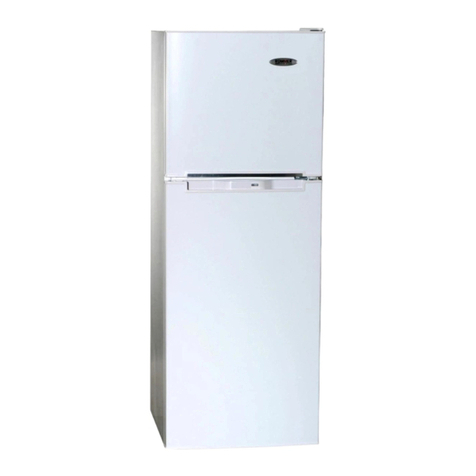
ROMMER
ROMMER F 241 A+ User manual
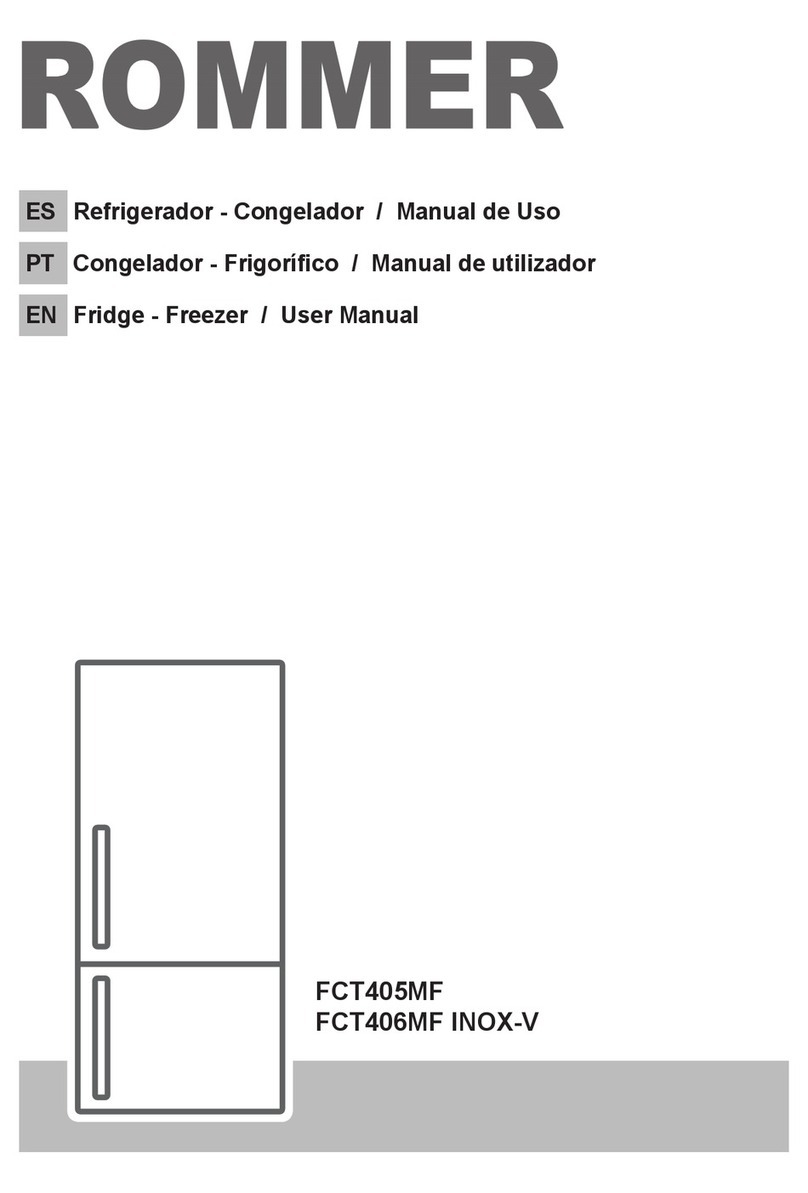
ROMMER
ROMMER FCT405MF User manual
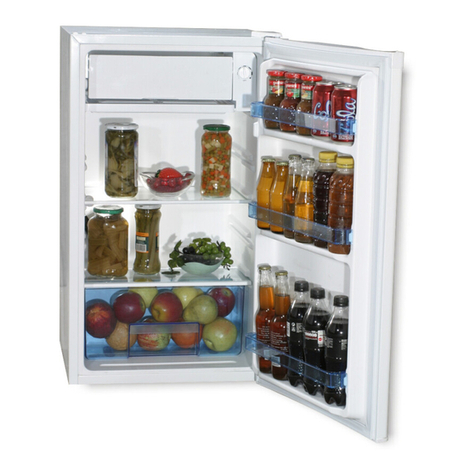
ROMMER
ROMMER F 101 A+ User manual
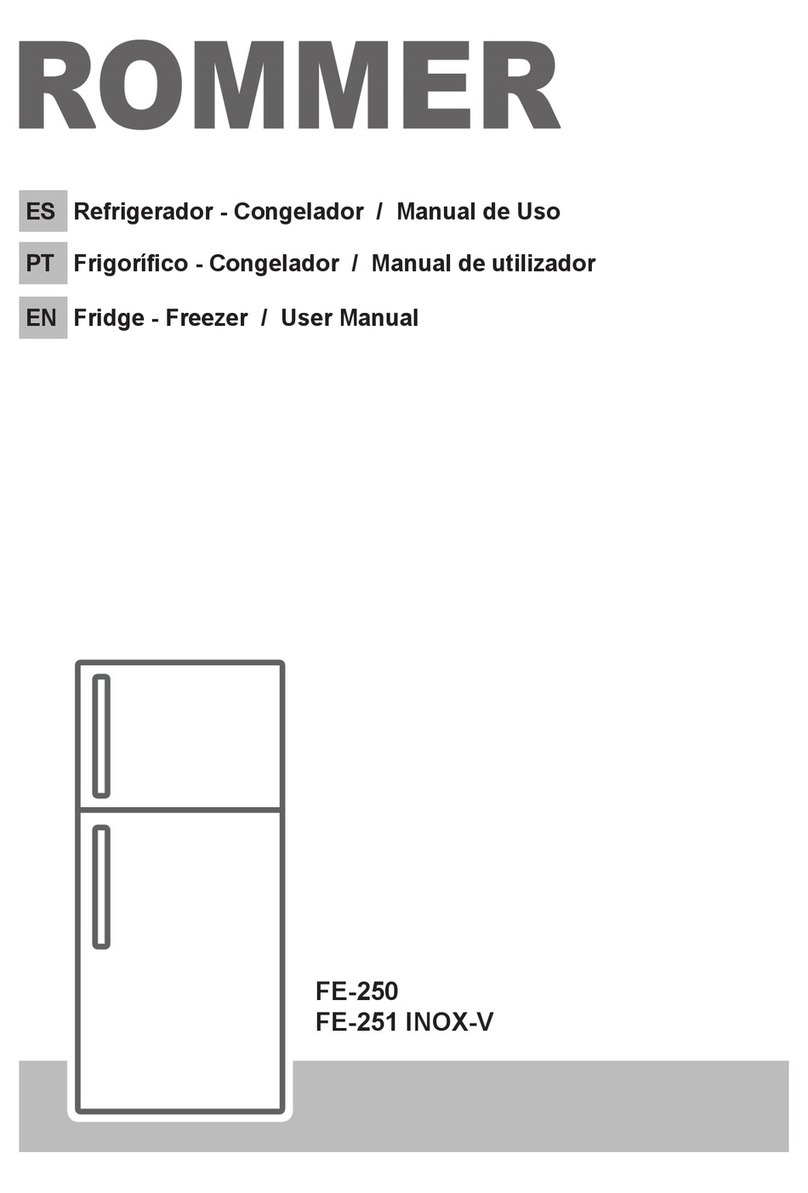
ROMMER
ROMMER FE-250 User manual

ROMMER
ROMMER FCM 316 INOX User manual
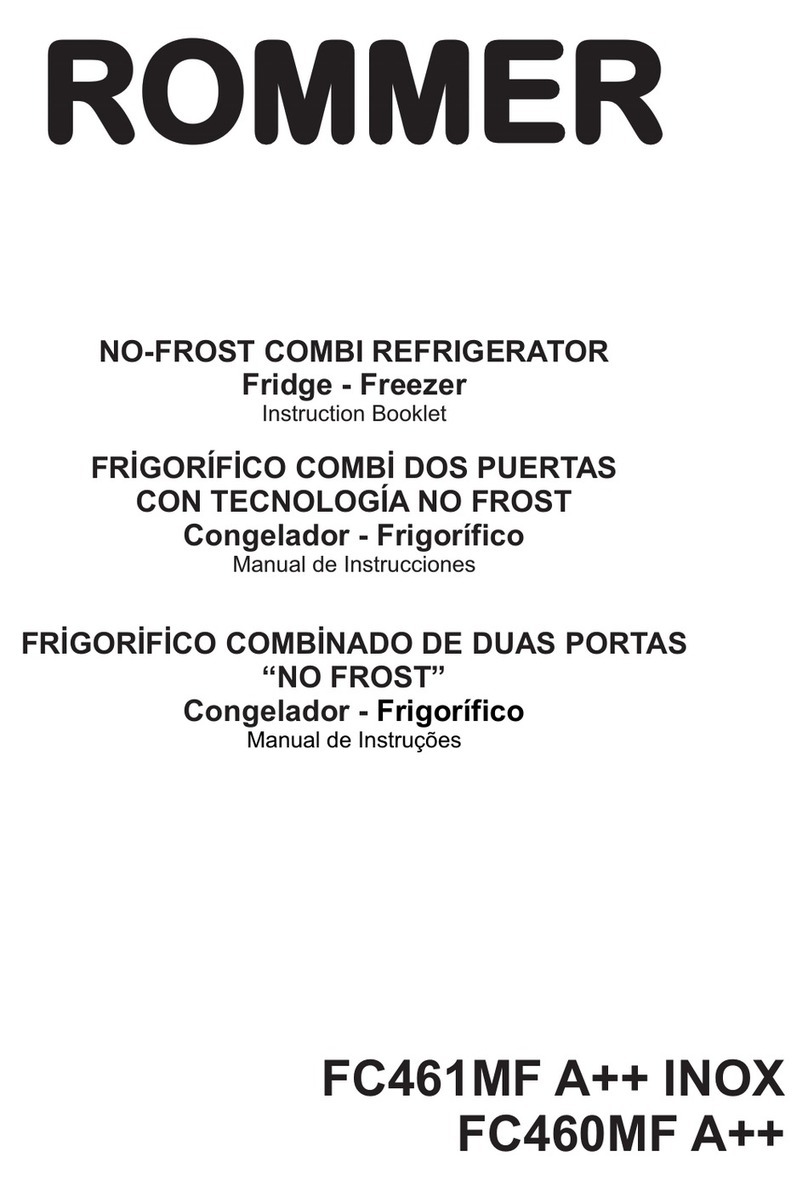
ROMMER
ROMMER FC461MF A++ INOX User manual
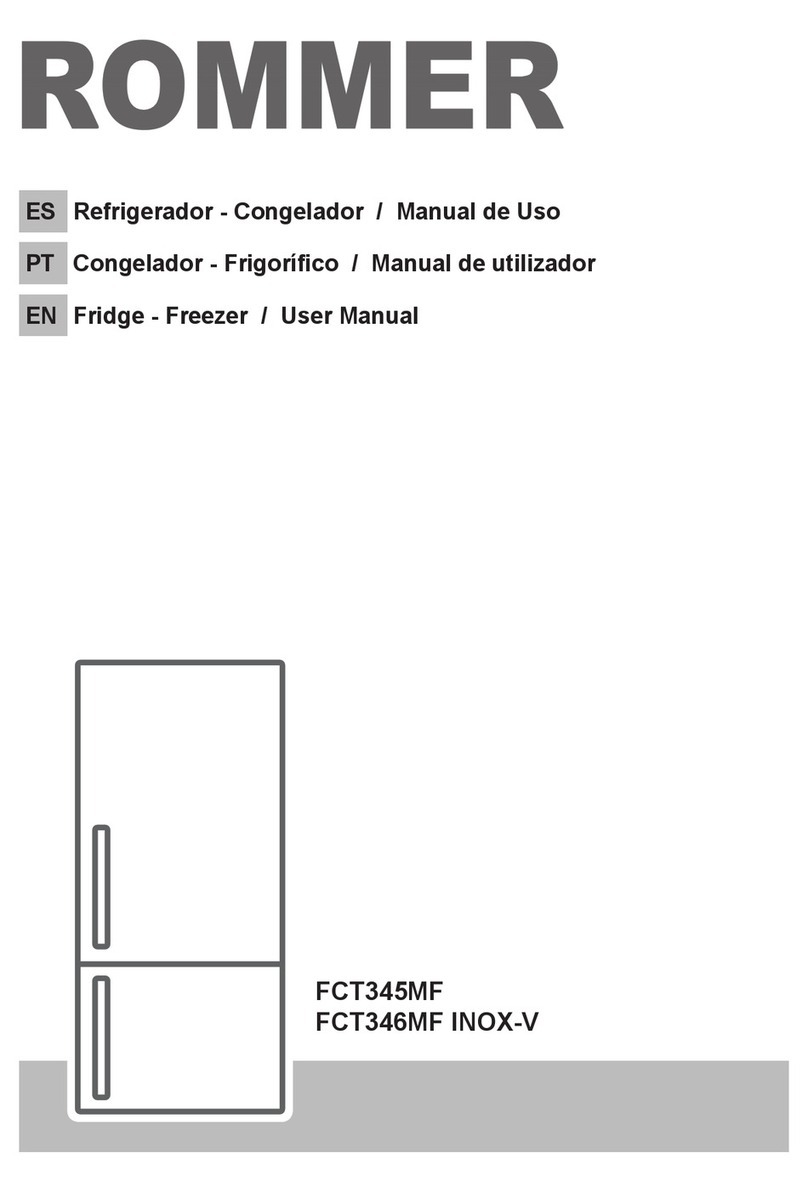
ROMMER
ROMMER FCT345MF User manual
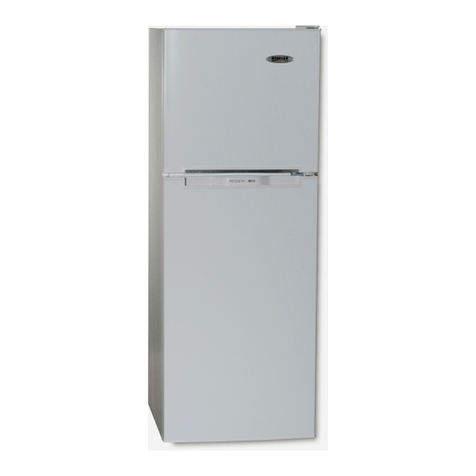
ROMMER
ROMMER FV-290 A+ User manual
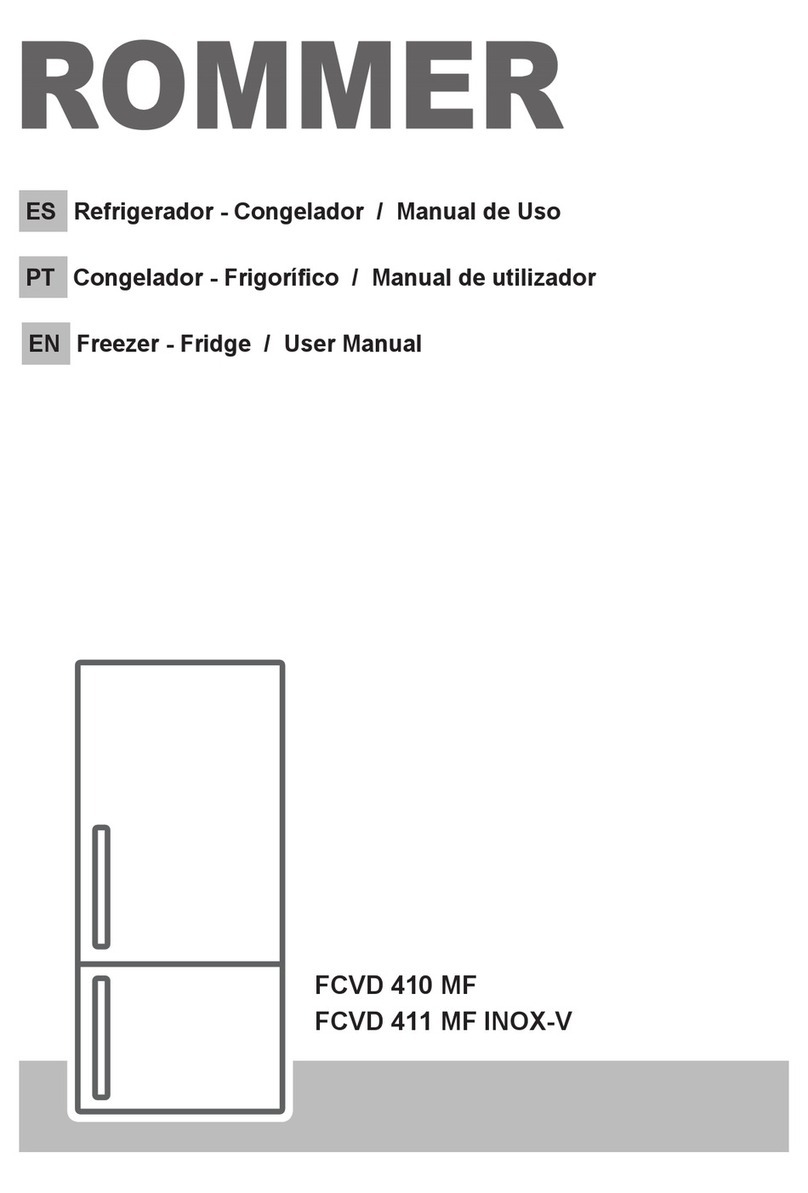
ROMMER
ROMMER FCVD 410 MF User manual
Popular Refrigerator manuals by other brands
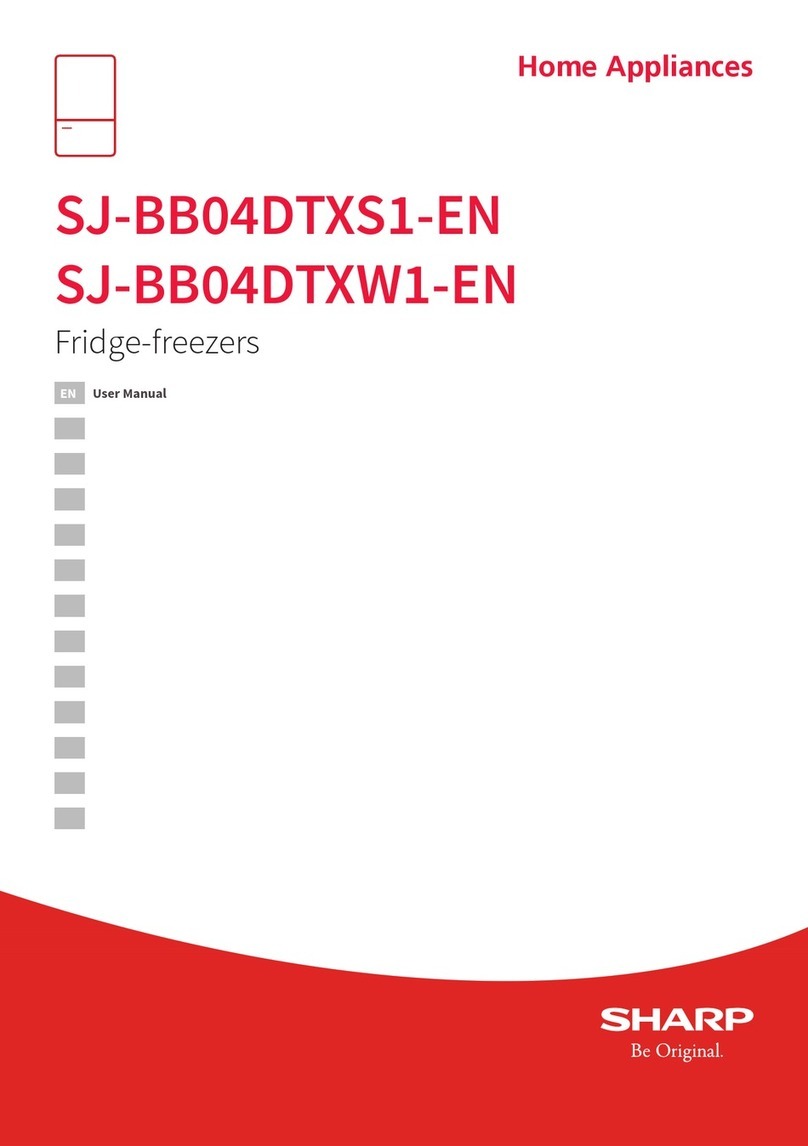
Sharp
Sharp SJ-BB04DTXS1-EN user manual
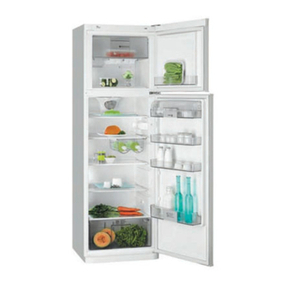
Fagor
Fagor FD-291NF Instructions for use

GE
GE GE Energy Star GDSL3KCYLS Dimensions and installation information
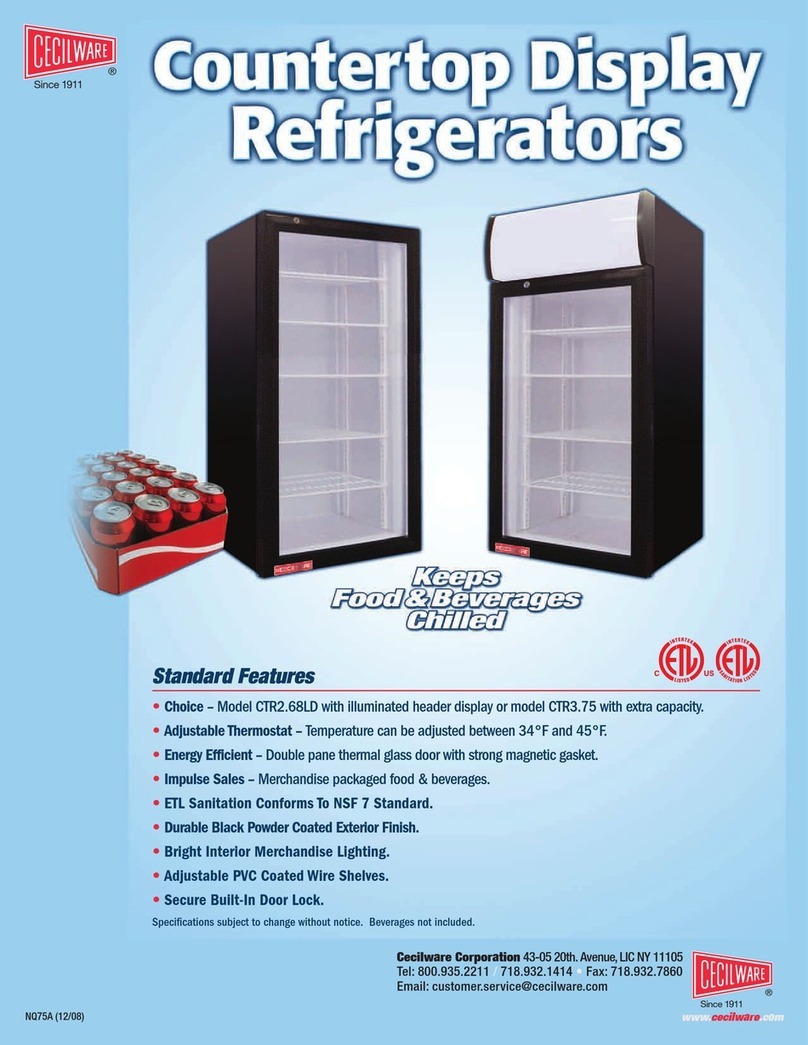
Cecilware
Cecilware 8725 Specification sheet
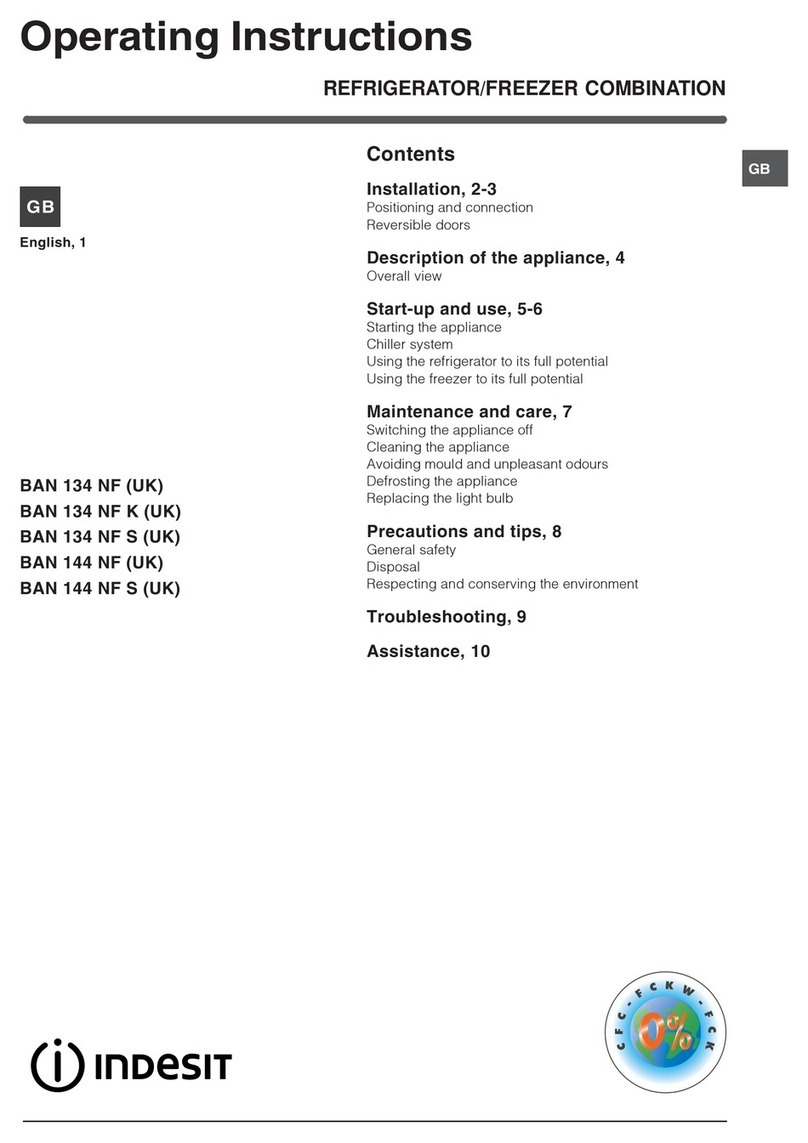
Indesit
Indesit BAN 134 NF K operating instructions
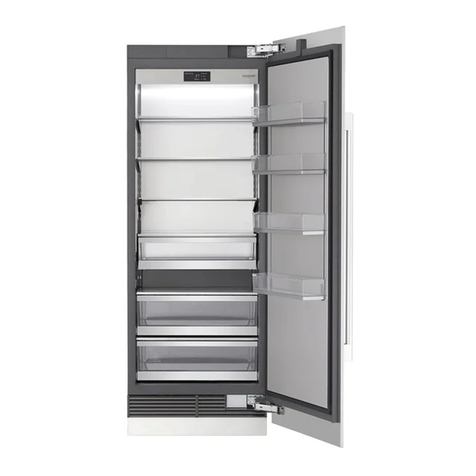
Signature Kitchen Suite
Signature Kitchen Suite SKSCR3001P owner's manual
